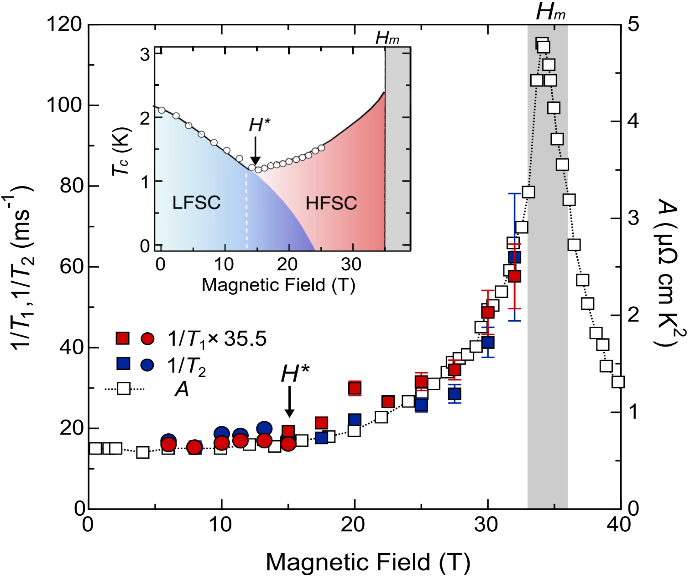Y. Tokunaga, Japan Atomic Energy Agency, Tokai, Japan, M. Horvatić and Steffen Krämer, LNCMI Grenoble.
The uranium-based superconductor UTe2 provides an attractive platform for studying the novel physics of spin-triplet and topological superconductivity in bulk materials. Resistivity measurements performed in 2019 at LNCMI, both in continuous and pulsed fields, revealed that superconductivity in UTe2 is significantly enhanced when the magnetic field (H) is applied along the crystallographic b axis (inset of figure). This leads to an increase of the upper critical field up to the field of a metamagnetic transition at Hm = 35 T. It was proposed that an essential ingredient for this field-reinforced superconductivity is the interplay with U-5f-electron spin fluctuations.To confirm the presence and elucidate the nature of spin fluctuations in UTe2, we conducted 125Te-NMR experiments in high magnetic fields using specially prepared, 125Te-enriched, high-quality single crystals having Tc = 2.0 K, synthetized using the molten-salt flux method discovered recently by our team. The natural abundance of 125Te is only 7 %, so that our enrichment up to 99 % largely enhanced the NMR signal, allowing us to measure the field dependence of the NMR relaxation rates 1/T1 and 1/T2 up to 32 T.
The observed magnetic-field dependence of these data for H || b (figure) and the scaling between the two relaxation rates, T2-1/T1-1 ≈ 36, demonstrates that the dominant fluctuations in this material are longitudinal ones. While 1/T1 and 1/T2 are nearly field independent at lower fields, both quantities start to increase above about 15 T and show a tendency to diverge above 32 T, where the NMR spin-echo signal becomes unobservable because T2 becomes shorter than the dead time of our NMR spectrometer. This confirms the divergence of spin fluctuations near the field-induced metamagnetic transition at Hm. Previous macroscopic studies gave H* ≈ 15 T as the characteristic field above which Tc shows an upturn and a high-field superconducting phase emerges on top of a low-field superconducting phase (inset of figure). Our NMR results show that H* is also the characteristic field above which spin fluctuations begin to develop on approaching the metamagnetic transition, confirming that these fluctuations indeed enhance the pairing interactions.

Figure: Magnetic-field dependence of 1/T2 and 1/T1 (scaled by a factor 35.5) in UTe2 for H || b, compared to the previously published quadratic coefficient A of the low-T resistivity data. The data provide a direct signature of longitudinal spin fluctuations related to the metamagnetic transition at 35 T. Inset: Field-dependent Tc data and corresponding schematic H-T phase diagram, presenting a high-field (HFSC) as well as a low-field (LFSC) superconducting (SC) phase.
Longitudinal Spin Fluctuations Driving Field-Reinforced Superconductivity in UTe2, T. Y. Tokunaga, H. Sakai, S. Kambe, P. Opletal, Y. Tokiwa, Y. Haga, S. Kitagawa, K. Ishida, D. Aoki, G. Knebel, G. Lapertot, S. Krämer, and M. Horvatić, Phys. Rev. Lett. 131, 226503 (2023).
https://journals.aps.org/prl/abstract/10.1103/PhysRevLett.131.226503
Contact: tokunaga.yo@jaea.go.jp, mladen.horvatic@lncmi.cnrs.fr






